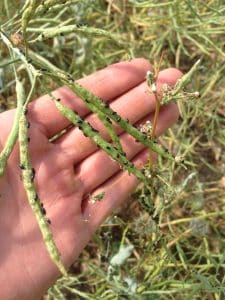Late-season flea beetles. Next generation adults are emerging (these are the ones that will overwinter to attack seedlings next spring) and we’ve heard of some serious cases. Flea beetles feeding on canola leaves and pods are unlikely to cause an economic loss. Entomologists have not set thresholds for late season flea beetle feeding, but it’s generally believed that numbers have to be very high — perhaps 100 per plant — before economic losses occur. Flea beetles are also be highly variable at this time of year, with high numbers on some plants and next to none on others. Often they can found concentrated on plants along the headland that have greener branches, so be sure to scout into the field when assessing the impact. Once green material is gone from within the canopy, watch for pod feeding. If canola growers decide to spray field edges with high counts, make sure to use a product with an appropriate pre-harvest interval. Two good follow-up questions.
Small berthas. We’ve heard of some fields with bertha numbers that exceed the threshold (which is ~15 to 20 per square metre) but the worms are small. You probably don’t have to count worms that are smaller than half an inch long, but come back every few days to see if they’ve grown up. This “worm size and thresholds” topic comes up during this podcast.
Leathery pods and lygus risk. The threat of yield loss from lygus feeding generally ends when most pods become “leathery” and when seeds inside are no longer squishy. As outer pod tissue toughens up and seeds become “firm to roll”, lygus can no longer penetrate the pods. More on lygus.
Grasshoppers on the edge. Grasshoppers are eating canola at some field edges. These numbers seem to be rising as cereals mature and are cut, and grasshoppers are looking for a new food source. Feeding damage may look bad in specific patches at field edges, but the area is often quite small. Scouting tips and thresholds. If they’re over thresholds in a small area, you could spot spray or not bother. But check every few days to make sure the area stays small. Grasshoppers were part of this quiz.
Seeing anything unusual? We want to stay on top of any new canola-eating insects. So if you see anything you don’t recognize, please take some good photos (following these tips) and share them with us. We’ll check with our experts friends to provide you with an identification.
Pre-harvest intervals important if spot spraying this late in the season.


